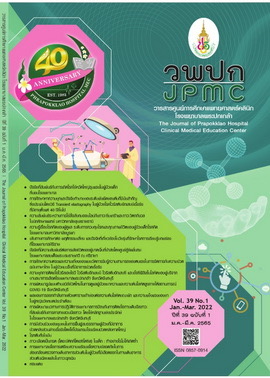Pediatric Diabetic Ketoacidosis: How to Prevent Recurrent Episodes
Main Article Content
Abstract
Diabetes is a chronic disease that tends to be on the increase and is also a public health problem worldwide. The limitations of caring for children with type I diabetes include dietary control, exercise, daily physical activities or even insulin injections. Therefore, a multidisciplinary team should provide care for both the children and their families. The important role of nurse are to provide knowledge, advice, and re-evaluation of their understanding and utilization. Moreover, providing knowledge and skills in caring for oneself can help the children and prevent acute complications, especially diabetic ketoacidosis (DKA) that causes dehydration, brain edema and in some cases death.
This article focuses on the nursing roles to provide knowledge about diabetes, insulin injection, calculation of daily dietary intake, self-monitoring of blood glucose, and basic health problem solutions. These will help children to control their blood glucose levels and to prevent a recurrence of diabetic ketosis.
Article Details

This work is licensed under a Creative Commons Attribution-NonCommercial-NoDerivatives 4.0 International License.
References
Diabetes Association of Thailand under The Patronage of Her Royel Highness Princess Maha Chari Sirindhorn, The endocrine society of Thailand,Departmant of medical services, National Health Security Office (NHSO).Clinical practice guideline for diabetes 2017. 3rd ed. Pathumthani: Romyen; 2560.
Gale EAM. The rise of childhood type 1 diabetes in the 20th century. Diabetes2002 ;51:3353-61.
Barski L, Nevzorov R, Jotkowitz A, Rabaev E, Zektser M, Zeller L, et al. Comparison of diabetic ketoacidosis in patients withtype-1 and type-2 diabetes mellitus. Am J Med Sci 2013;345(4):326-30.
Thai Society for Pediatric Endocrinology. Management guideline for diabetic ketoacidosis and hyperglycemic hyperosmolar statein children and adolescents. Bangkok: Thai Society for Pediatric Endocrinology; 2020.
American Diabetes Association. 13. Children and adolescents: standards ofmedical care in diabetes-2019. Diabetes Care 2019;42(Suppl1):S148-64.
International Diabetes Federation. IDF diabetes atlas, 7th ed.Netherlands: International Diabetes Federation;2015.
Betts PR, Jefferson IG, Swift PG. Diabetes care in childhood and adolescence. Diabet Med 2002;19 (Suppl 4):61-5.
Szypowska A, Skórka A. The risk factors of ketoacidosis in children withnewly diagnosed type 1 diabetes mellitus. Pediatr Diabetes2011;12(4 Pt1):302-6.
Musiksukont S. Pediatric nursing V2. Bangkok: Sahamitr Printing & Publishing Company Limited; 2015.

